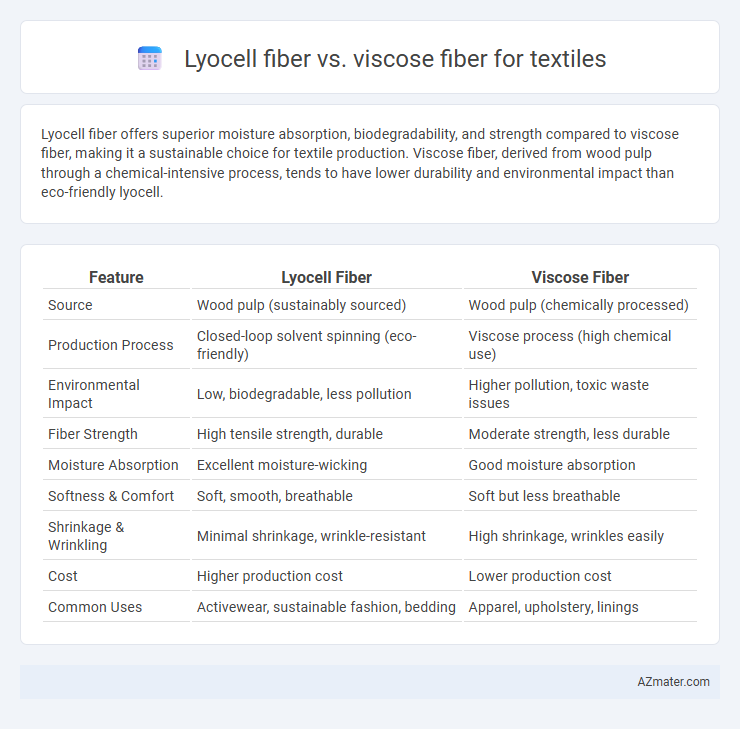Lyocell fiber offers superior moisture absorption, biodegradability, and strength compared to viscose fiber, making it a sustainable choice for textile production. Viscose fiber, derived from wood pulp through a chemical-intensive process, tends to have lower durability and environmental impact than eco-friendly lyocell.
Table of Comparison
| Feature | Lyocell Fiber | Viscose Fiber |
|---|---|---|
| Source | Wood pulp (sustainably sourced) | Wood pulp (chemically processed) |
| Production Process | Closed-loop solvent spinning (eco-friendly) | Viscose process (high chemical use) |
| Environmental Impact | Low, biodegradable, less pollution | Higher pollution, toxic waste issues |
| Fiber Strength | High tensile strength, durable | Moderate strength, less durable |
| Moisture Absorption | Excellent moisture-wicking | Good moisture absorption |
| Softness & Comfort | Soft, smooth, breathable | Soft but less breathable |
| Shrinkage & Wrinkling | Minimal shrinkage, wrinkle-resistant | High shrinkage, wrinkles easily |
| Cost | Higher production cost | Lower production cost |
| Common Uses | Activewear, sustainable fashion, bedding | Apparel, upholstery, linings |
Introduction to Lyocell and Viscose Fibers
Lyocell fiber, derived from sustainably sourced wood pulp using a closed-loop process, offers superior moisture absorption and breathability compared to viscose fiber, which is chemically produced from cellulose but involves more environmental pollutants. Both fibers are widely used in textile manufacturing for their soft texture and versatility, yet lyocell's eco-friendly production and biodegradability make it a preferred choice for sustainable fashion. Viscose fibers provide a silky feel and vibrant dye retention, though their production relies heavily on toxic chemicals, raising environmental concerns.
Origin and Production Processes
Lyocell fiber is produced from sustainably sourced eucalyptus wood pulp through a closed-loop solvent spinning process that recycles water and solvents, minimizing environmental impact. Viscose fiber originates from wood cellulose, typically derived from beech, pine, or bamboo, and is manufactured using a chemical-intensive viscose process involving carbon disulfide and sodium hydroxide. The production of Lyocell is considered more eco-friendly compared to viscose due to its lower toxicity and higher resource efficiency in fiber extraction and regeneration.
Environmental Impact Comparison
Lyocell fiber, produced through a closed-loop process, significantly reduces chemical waste and water consumption compared to viscose, which relies on toxic chemicals like carbon disulfide and results in higher environmental pollution. The biodegradable nature of Lyocell combined with its sustainable sourcing from sustainably managed eucalyptus trees ensures a lower carbon footprint and less deforestation in comparison to viscose, often derived from hardwood or bamboo with intensive chemical processing. Lyocell's superior eco-friendly properties make it a preferred choice for sustainable textile manufacturing, offering a marked improvement over traditional viscose in terms of environmental impact.
Chemical Use and Emissions
Lyocell fiber production uses a closed-loop process that recycles 99% of chemicals, minimizing environmental emissions compared to viscose fiber, which relies on carbon disulfide and sulfuric acid with high chemical discharge. Viscose processing emits significant amounts of toxic substances that contribute to air and water pollution, while Lyocell's eco-friendly solvent, N-methylmorpholine N-oxide, is less harmful and rapidly biodegradable. These chemical and emission differences make Lyocell a more sustainable choice for textile manufacturing with reduced ecological impact.
Fiber Properties and Characteristics
Lyocell fiber offers superior moisture absorption and breathability compared to viscose, enhancing comfort in textile applications. Its high tensile strength and resistance to shrinking and wrinkling make Lyocell more durable and easier to maintain than viscose fibers. Viscose fibers, derived from wood pulp, provide a soft, silky feel but have lower wet strength and are more prone to deformation and environmental impact due to less sustainable production methods.
Comfort and Performance in Textiles
Lyocell fiber offers superior moisture-wicking properties and breathability compared to viscose fiber, enhancing wearer comfort in textiles. Its high tensile strength and durability ensure better performance in activewear and everyday garments, while viscose tends to degrade faster and feel less resilient. Lyocell's eco-friendly production and softness make it a preferred choice for sustainable, comfortable textile applications.
Durability and Maintenance Requirements
Lyocell fiber exhibits superior durability compared to viscose due to its stronger molecular structure and enhanced moisture regain, which results in less fabric weakening during washing and wear. Viscose tends to lose strength when wet and degrades faster under frequent laundering, requiring more delicate care and lower washing temperatures. Maintenance of lyocell is generally easier, with better resistance to shrinkage and fewer pilling issues, making it ideal for longer-lasting textile applications.
Cost and Market Availability
Lyocell fiber generally costs more than viscose due to its more environmentally friendly and sustainable production process involving non-toxic solvents and closed-loop systems. Viscose remains more widely available in the textile market because of its long-established manufacturing infrastructure and lower raw material expenses. The growing demand for eco-friendly fibers is gradually increasing Lyocell's market presence, although viscose still dominates cost-sensitive applications.
Sustainability and Biodegradability
Lyocell fiber, produced through a closed-loop process using sustainably sourced wood pulp, significantly reduces environmental impact compared to viscose fiber, which often involves toxic chemical treatments and higher water consumption. Both fibers are biodegradable, but lyocell decomposes more efficiently due to its purer cellulose content and eco-friendly manufacturing methods. The superior sustainability profile of lyocell fiber makes it a preferred choice for environmentally conscious textile production.
Choosing Between Lyocell and Viscose
Choosing between Lyocell and Viscose fibers involves evaluating their environmental impact and fabric performance; Lyocell is produced using a closed-loop process that recycles water and solvents, making it more sustainable than Viscose, which typically employs chemically intensive methods. Lyocell fibers offer superior strength, moisture absorption, and softness, contributing to durable and comfortable textiles, while Viscose provides a silk-like feel but tends to weaken when wet and may contribute to higher pollution levels during manufacturing. For eco-conscious brands and consumers prioritizing longevity and reduced environmental footprint, Lyocell emerges as the preferred choice compared to traditional Viscose fibers.

Infographic: Lyocell fiber vs Viscose fiber for Textile
 azmater.com
azmater.com